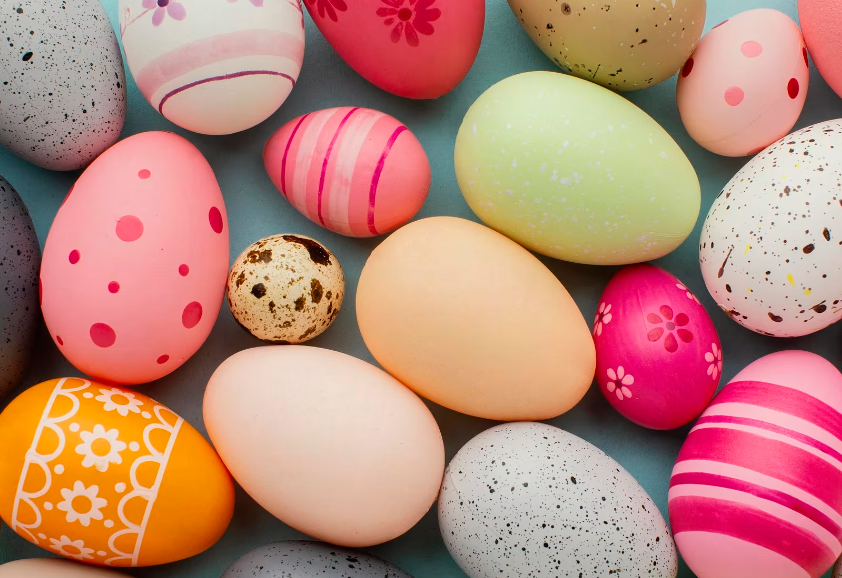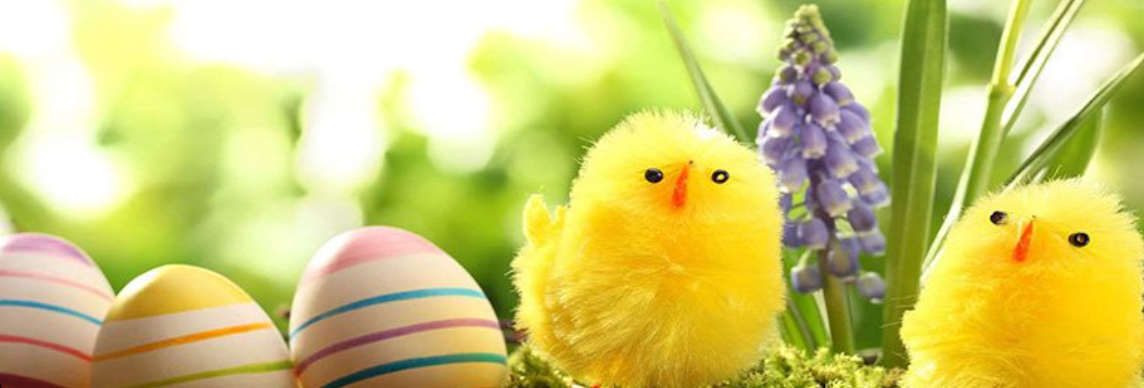Happy Easter!
March 31, 2024

This is a subtitle for your new post

Happy Easter everyone! We have put together some interesting facts about Easter that you may or may not know!
Easter i s a prominent Christian holiday, carries immense historical, cultural, and religious significance. While many perceive Easter solely as a celebration of the resurrection of Jesus Christ, the holiday encompasses a myriad of fascinating elements.
1. Origins and Etymology:
The word "Easter" is derived from the Old English term "Ēastre" or "Ēostre," which is associated with a pagan spring goddess. These pagan festivities were eventually incorporated into the Christian celebration of Christ's resurrection, resulting in the Easter we know today.
2. The Date of Easter:
Unlike Christmas, which is celebrated on a fixed date, the date of Easter varies each year. The holiday falls on the first Sunday following the first full moon after the vernal equinox, ranging from March 22 to April 25. This calculation is based on ancient astronomical and ecclesiastical calculations.
3. The Easter Bunny:
The tradition of the Easter Bunny delivering eggs can be traced back to 17th-century German immigrants who settled in Pennsylvania. Rabbits, known for their high fertility rates, symbolize new life and are closely associated with spring and rebirth—an idea that harmonized with the Easter theme.
4. Easter Eggs and Their Symbolism:
Decorating and exchanging eggs has long been an integral part of Easter celebrations worldwide. Eggs have been seen as symbols of fertility, new beginnings, and resurrection across many cultures. The practice of dyeing eggs is believed to have originated from early Christians who stained them red to represent the blood of Christ.
5. Egg Rolling:
Egg rolling is a cherished Easter tradition observed in various countries, but perhaps most famously in the United States. The activity involves participants racing to roll eggs down a hill, with the egg that travels the farthest without breaking being declared the winner. The White House in Washington D.C. annually hosts an Egg Roll on its lawn.
6. The Lenten Season:
Easter is preceded by the Lenten season, a 40-day period of fasting and reflection in many Christian traditions. This period serves to symbolize the 40 days Jesus spent fasting in the wilderness. It remains a time for Christians to purify their hearts, engage in acts of self-discipline, and deepen their spiritual devotion.
7. Easter Parades and Processions:
Easter parades, often featuring colorful floats, music, and special attire, have been an integral part of the holiday's celebration in many countries. The most renowned among them is New York City's annual Easter Parade and Bonnet Festival on Fifth Avenue, where participants don elaborate and creatively designed hats.
8. Orthodox Easter:
While Easter is generally celebrated on the same Sunday by most Christians, Orthodox Christians use the Julian calendar. Consequently, their celebration often falls on a different date. Orthodox Easter is rich in customs, with famous traditions like the Holy Fire ceremony in Jerusalem and the Midnight Resurrection service.
9. Global Traditions and Local Customs:
Easter traditions differ significantly across nations and regions, blending local customs with core religious observations. Examples include Spain's Semana Santa processions, Greece's smashing of pottery for good luck, and Haux, France, where thousands of omelets are cooked in a giant pan as part of a grand communal feast.
10. Easter's Influence on Art and Literature:
Easter has been a recurring motif in art and literature for centuries. It has captured the imaginations of renowned painters, composers, and writers throughout history. Masterpieces such as Leonardo da Vinci's "The Last Supper," Johann Sebastian Bach's "St. Matthew Passion," and Oscar Wilde's "The Selfish Giant" are just a few notable examples.
Easter i s a prominent Christian holiday, carries immense historical, cultural, and religious significance. While many perceive Easter solely as a celebration of the resurrection of Jesus Christ, the holiday encompasses a myriad of fascinating elements.
1. Origins and Etymology:
The word "Easter" is derived from the Old English term "Ēastre" or "Ēostre," which is associated with a pagan spring goddess. These pagan festivities were eventually incorporated into the Christian celebration of Christ's resurrection, resulting in the Easter we know today.
2. The Date of Easter:
Unlike Christmas, which is celebrated on a fixed date, the date of Easter varies each year. The holiday falls on the first Sunday following the first full moon after the vernal equinox, ranging from March 22 to April 25. This calculation is based on ancient astronomical and ecclesiastical calculations.
3. The Easter Bunny:
The tradition of the Easter Bunny delivering eggs can be traced back to 17th-century German immigrants who settled in Pennsylvania. Rabbits, known for their high fertility rates, symbolize new life and are closely associated with spring and rebirth—an idea that harmonized with the Easter theme.
4. Easter Eggs and Their Symbolism:
Decorating and exchanging eggs has long been an integral part of Easter celebrations worldwide. Eggs have been seen as symbols of fertility, new beginnings, and resurrection across many cultures. The practice of dyeing eggs is believed to have originated from early Christians who stained them red to represent the blood of Christ.
5. Egg Rolling:
Egg rolling is a cherished Easter tradition observed in various countries, but perhaps most famously in the United States. The activity involves participants racing to roll eggs down a hill, with the egg that travels the farthest without breaking being declared the winner. The White House in Washington D.C. annually hosts an Egg Roll on its lawn.
6. The Lenten Season:
Easter is preceded by the Lenten season, a 40-day period of fasting and reflection in many Christian traditions. This period serves to symbolize the 40 days Jesus spent fasting in the wilderness. It remains a time for Christians to purify their hearts, engage in acts of self-discipline, and deepen their spiritual devotion.
7. Easter Parades and Processions:
Easter parades, often featuring colorful floats, music, and special attire, have been an integral part of the holiday's celebration in many countries. The most renowned among them is New York City's annual Easter Parade and Bonnet Festival on Fifth Avenue, where participants don elaborate and creatively designed hats.
8. Orthodox Easter:
While Easter is generally celebrated on the same Sunday by most Christians, Orthodox Christians use the Julian calendar. Consequently, their celebration often falls on a different date. Orthodox Easter is rich in customs, with famous traditions like the Holy Fire ceremony in Jerusalem and the Midnight Resurrection service.
9. Global Traditions and Local Customs:
Easter traditions differ significantly across nations and regions, blending local customs with core religious observations. Examples include Spain's Semana Santa processions, Greece's smashing of pottery for good luck, and Haux, France, where thousands of omelets are cooked in a giant pan as part of a grand communal feast.
10. Easter's Influence on Art and Literature:
Easter has been a recurring motif in art and literature for centuries. It has captured the imaginations of renowned painters, composers, and writers throughout history. Masterpieces such as Leonardo da Vinci's "The Last Supper," Johann Sebastian Bach's "St. Matthew Passion," and Oscar Wilde's "The Selfish Giant" are just a few notable examples.

By Neil Kinnerly
•
October 31, 2025
Halloween is nearly here and it’s always a good time to add a little spooky fun to your day, whether you’re hanging out with friends, getting your place ready, or just enjoying the autumn vibes. Before you dive into the celebrations, we thought it would be cool to share some interesting things about Halloween in the UK and some local Swansea stories to get you in the mood. Halloween actually has really old roots here in the UK. It goes back to an ancient Celtic festival called Samhain. People used to celebrate the end of the harvest season and the start of the cold, dark winter. Back then, they believed that the boundary between the living world and the spirit world was thinner around this time of year. Because of that, they thought ghosts and spirits could cross over and roam the earth. It was a time to light bonfires and wear costumes to keep those spirits away. The pumpkin carving tradition that’s so popular today actually started a little differently. In Ireland and Scotland, people used to carve faces into turnips or other root vegetables to scare off wandering spirits. When Irish immigrants came to America, they discovered pumpkins were easier to carve and much bigger, so the jack-o’-lantern as we know it was born. But if you want to keep it authentic, you could always try carving a turnip this Halloween. Trick or treating is another interesting tradition. It didn’t really become popular in the UK until the 1980s. Before that, kids went “guising” which meant dressing up in costumes and going door to door to perform songs or jokes in exchange for treats. It was less about threats and more about entertainment. So when you’re knocking on doors this year, you’re taking part in a tradition that’s only a few decades old here but has deep roots in earlier customs. Swansea itself has plenty of spooky stories and places that make Halloween feel a bit more real. For example, Swansea Castle is said to be haunted, and people have reported strange noises and ghostly sightings there. The Maritime Quarter has its own legends of mysterious figures wandering the docks late at night. If you’re up for a bit of local adventure, grabbing a few friends and exploring some of these spots could be a fun way to get into the Halloween spirit. If you’re staying in your student house, adding some decorations like cobwebs, spooky lights or even a hand-carved pumpkin can transform your place without much effort. You don’t have to go over the top to make it feel festive. And maybe set up a horror movie night with your housemates. Whether you prefer classic chills or silly scary comedies, it’s a great way to relax and have some laughs. One more fun fact - did you know that in some parts of the UK people still follow the old tradition of “snap-apple” at Halloween? It’s a game where apples are hung from a string and you try to bite one without using your hands. It’s messy but a good laugh with friends. Whether you’re planning to head out, stay in or just enjoy some snacks and spooky stories, it’s a great chance to take a break and have some fun. We hope your Halloween is full of good times, a few surprises and plenty of treats. If you come across any great local events or have some cool decorations or costumes to show off, we’d love to hear from you.




